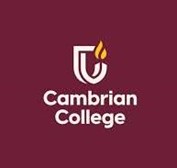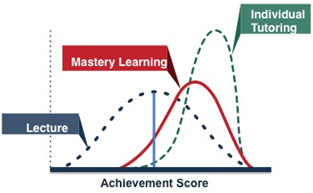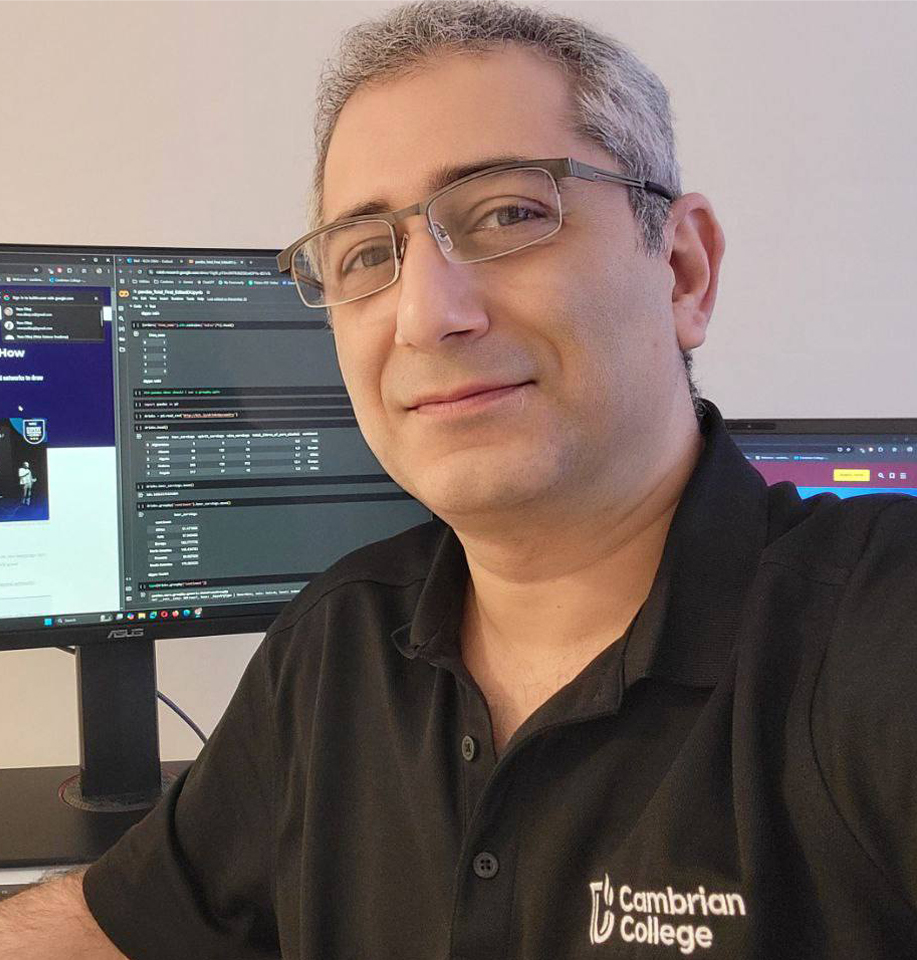
Challenge
Dr. Reza Dibaj, a Professor at the School of Information Technology at Cambrian College in Sudbury, teaches various computer science and Artificial Intelligence (AI) courses. He has a clear vision to guide the application of AI in education: “The key is not to ask AI to go through the challenge FOR you but to ask AI to go through the challenge WITH you.” This principle is particularly relevant for student learning and valuable for instructors using AI to help with teaching, course design and assessment.
Professor Dibaj characterizes Generative Artificial Intelligence (GenAI) as a “super tutor” for students, helping them to improve their skills from below average to above average and from above average to exceptional. For professors, AI is a “super teaching assistant,” a lesson planner, an administrative assistant and an assessment aid.
Professor Dibaj’s use of GenAI is built around the careful choice and application of various AI tools to enhance the teaching and learning of AI.
Experimentation
Teaching Tools: Professor Dibaj describes the role of the teacher shifting from the “oracle” or the source of knowledge to the coach who conveys core content while instilling the strategies and joy of learning. To support this teaching philosophy, he uses AI tools to present information in the best possible formats for comprehension and practical learning.
- Napkin AI is a tool that transforms uploaded text into visuals such as flow charts, data graphics, mind maps and images. Professor Dibaj chooses the text he wants to present in the classroom and instructs Napkin AI to represent the content in different visual styles. He chooses the most suitable for his purposes, edits for content and style, and integrates it into effective classroom presentations. Professor Dibaj finds this especially useful in a course on Storytelling with Data.
- Gamma helps Professor Dibaj create slides that feature charts, diagrams, tables and images based on the content he uploads. This AI-powered presentation tool efficiently integrates materials from platforms like Instagram, YouTube and other sources into customized slide decks. To ensure accuracy, he edits all slide content before integrating it into class presentations and mobile apps for students.
- ChatGPT plays an essential role in lecture preparation. Professor Dibaj outlines the topic he wishes to cover and the prompts he wants the app to apply. ChatGPT creates a lecture of a length that suits the content. After reviewing and refining the suggested content, he enhances it further using tools like Napkin AI and Gamma to include visual aids for enhanced learning. He describes this process as “creating everything from scratch — your scratch” to emphasize professors’ control over the process.
- Google NotebookLM is an AI tool with versatile applications. It can transform PDFs into podcasts by summarizing key information, generating engaging scripts, using synthesized voices for narration, and incorporating audio elements. For educators like Professor Dibaj, NotebookLM offers significant benefits. It can enhance learning by summarizing content and making it more accessible, potentially aiding in creating study materials.
Learning Strategies: Student performance typically follows a standard bell curve in a traditional classroom atmosphere. However, Professor Dibaj believes GenAI can significantly enhance learning and achievement. It shifts the experience from a conventional classroom or mastery learning approach to a more personalized, one-on-one tutoring dynamic. As a super tutor, GenAI empowers average students to excel, transforming their learning outcomes, as the following image depicts.

Source: 5 Tips: Learn more effectively in class with Mastery Learning – Coursera Blog
Professor Dibaj’s two-hour classes blend lectures, video presentations and challenging problem-solving tasks. Using GenAI enhances students’ research capabilities and boosts their learning abilities. Individual work is supplemented with small group work to encourage the development of soft skills such as communication and cooperation.
Learning how to code is at the core of many courses he teaches, and in-class and at-home assignments require developing code through extensive practice to acquire the necessary skills. AI tools serve as personalized tutors, helping students learn what they need to do and debug and refine their code. Professor Dibaj characterizes AI as “a kind sibling who sits beside you, lets you learn and assists you in fixing your issues when and where needed.” These AI tools empower the more efficient learning of the content and confident mastery of coding skills. Here are some examples:
- ChatGPT generates new problem statements for coding exercises and works step-by-step through the student’s learning journey, showing them how to proceed and ensuring they understand each concept before moving on. Students can always ask ChatGPT for further help and explanation, but they need to write the code and understand the core of what they do. The code is tested at the end of each exercise to ensure it is functioning and, if not, ChatGPT provides a precise analysis of problems.
- Gemini and Claude are other GenAI apps that offer similar functionalities to ChatGPT, guiding students through their learning experience until they achieve mastery.
- Coconote captures notes from audio and visual input, transforming lectures and supporting materials into notes, summaries, flashcards or podcasts. Professor Dibaj encourages its use because it focuses on presenting class-specific content in diverse formats tailored to different learning styles rather than providing direct answers to questions or detailed interpretations of content.
Assessment Practices: Professor Dibaj recognizes that the use of AI in education requires regulation and monitoring. For major projects, students submit their code with a video explaining each line. During online interviews concerning these submissions, he questions their choices to ensure their understanding of the process and the submission’s originality. This thorough approach helps maintain academic integrity.
Results
As Professor Dibaj teaches various computer science and AI courses, his varied and creative use of AI tools offers multiple benefits, enhancing teaching and learning experiences. This approach also gives students a solid foundation in understanding the capabilities of various AI tools. Guided by his instructions and revisions, content from multiple sources uploaded to selected apps is effectively tailored for optimal presentation and comprehension.
In his experience, once any initial hesitation is overcome and a professor is familiar with the tool, AI saves time, provides new insights and approaches to teaching, and creates formats that best illustrate the content and support student success.
AI also ensures consistent, impartial assessment with constructive feedback.
Next Improvement Steps
Professor Dibaj emphasizes that AI is not a replacement for teachers. Rather, it reshapes their roles. A blend of cutting-edge AI tools and traditional teaching approaches yields the best results for both students and educators. Students need to become better critical and divergent thinkers to effectively benefit from AI rather than passively consuming instant online information.
AI provides differentiated and personalized learning experiences. While particularly useful in teaching and learning within computer science and AI fields, many of the tools described above are equally applicable to teaching and learning in other discipline
For Further Information

Dr. Reza Dibaj
Professor
School of Information Technology
Cambrian College
Sudbury, Ontario